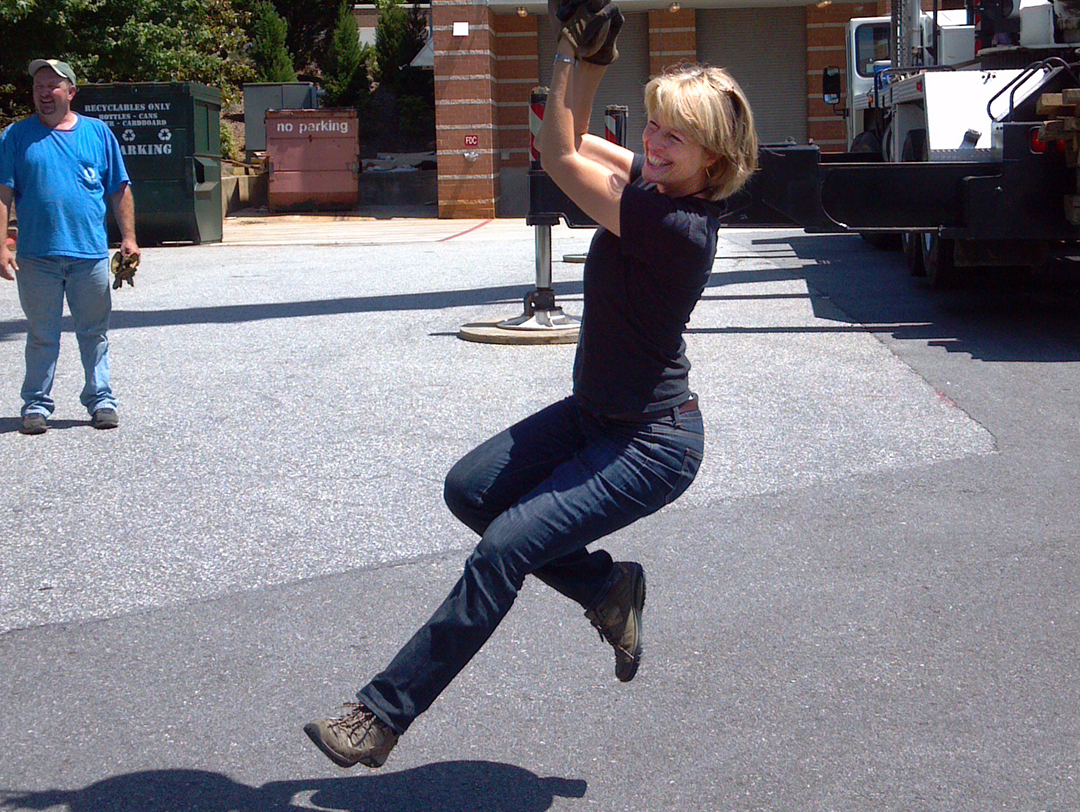 Deputy director Annelies Mondi swinging from a crane
Deputy director Annelies Mondi swinging from a crane
Beloved Deputy Director Annelies Mondi Retires After Decades of Service
Annelies Mondi says that, in some ways, she came in the back door of the Georgia Museum of Art, but after 34+ years of service she’s made an undeniable impact. She retired at the end of May after working in many different departments at the museum and with countless people across campus.
Mondi, who has been our deputy director since 2004, first got involved with the museum when a friend suggested that she look into the docent program after she graduated from the University of Georgia in 1984, with a degree in art history. Working to pay off her student loans, she cobbled together employment in the way that many 20-somethings who’ve fallen in love with Athens do. She worked as a commercial screen printer, in a frame shop, bussing tables at T-Bone’s Texas-Style Steakhouse on Baxter Street, selling books at Jackson Street Books and even painting the windshields of cars at dealerships with phrases like “4 x 4 Thunder Truck.”
“What’s a docent?” Mondi asked, a question she’s probably answered a thousand times since then, but that connection turned out to be the beginning of a lifetime in the museum field. After talking to then-curator Donald Keyes, she agreed to help him conduct research on the itinerant 19th-century painter George Cooke, a project that became an award-winning exhibition in 1991. From there, she took a temporary part-time job in the museum’s education department, working on the School Art Symposium, a statewide competition for high school students.
In 1988, interim director Carol Winthrop hired Mondi as a part-time preparator, working for Bruce Bowman to install exhibitions and move art, and her first full-time position at the museum came a little later, as an assistant registrar to Martha Blakeslee. The museum had moved to a then-state-of-the-art DOS-based electronic database known as AIMS, and Mondi dove right in to cleaning it up. If you know her, you know that she reacts to a big, complex, daunting project by rolling up her sleeves immediately. She thinks about it first, of course, and she carefully gathers information and input from everyone involved who might have an opinion or something valuable to add, but she’s never been afraid to get her hands dirty, including literally.
Mondi became associate registrar next, and then head registrar, overseeing the move of the collection in 1996 from the museum’s old building on North Campus to its new digs on East Campus. In fact, she’s seen that happen three times, what with moving it out of the East Campus building for the expansion and remodeling that concluded in 2011 and then back in. She served as head of the Southeastern Registrars Association and got to know others in the field. She also spent time at the Albany Museum of Art in southwest Georgia, helping it achieve accreditation, and took a sabbatical to work at the Princeton University Art Museum. Both off-site experiences taught her much about how other museums operate, and she brought back what she learned to make her home museum a better place.
In 2004, Mondi was named deputy director, only the second person ever to serve in that position, but she approached it with the same spirit of collaboration and persistence that she’s had her entire career. The Phase II campaign to expand the museum was well underway, and she attended meeting after meeting with the Office of University Architects as they planned the expansion and renovation. She describes those meetings with fondness, saying “everyone just wanted a successful project and wanted to work for it.” Mondi oversaw every aspect of the renovated building, but the Jane and Harry Willson Sculpture Garden was a particularly important place for her. She had gotten to know Mrs. Willson while in Albany, and the idea of the garden being reserved for woman sculptors was appealing to her. She also, as usual, enjoyed the logistics of planning out site placement for 3-D objects and working with shippers and riggers to move large, heavy, complicated works into the garden. Every time a new exhibition opened there, Mondi was in the thick of it, usually with a sun hat and a big smile as she talked to truck drivers and artists’ assistants.
Dale Couch, the museum’s curator emeritus of decorative arts, pointed out that Mondi’s role in the exhibition “Crafting History: Textiles, Metals and Ceramics at the University of Georgia” (2018) as well as many other curatorial areas was crucial. He said, “Her connoisseurship in modern craft was a crucial tool to the decorative arts program since its inception and I constantly relied on it. Her contributions are foundational for much of our collection and understanding of 20th-century craft in Georgia.” The number of exhibitions on which Mondi has served as an uncredited curator or critical contributor is a lengthy one.
Always eager to attack a large and thankless task, Mondi has been responsible for too many things to mention in her time here: every byzantine exhibition contract, so many international loans, penny pinching to make sure the budget could encompass ambitions beyond our means, knowing the name and priorities of every staff member, making time for students, preserving Athens art and history, nailing down recycling agreements with UGA’s Office of Sustainability. We cannot possibly list everything, but her work is present in everything we do. Her name might not be on much, but her spirit is in all of it.
